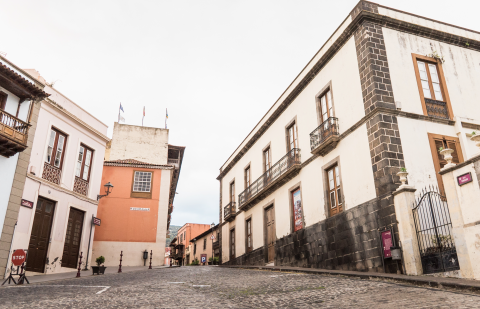10. Former Jesuit school

This is one of La Orotava’s most historic places. The current building is constructed in the classicist style of the mid-19th century. The previous building was the 18th-century San Luis Gonzaga Jesuit school.
The Jesuit order was one of the most powerful religious orders in Spain until its expulsion in 1767. The distinguishing feature of the order was its educational and intellectual nature. This school gave the Jesuits a lot of grief. Firstly, as a result of architectural problems in its construction. Secondly, due to the scarce local support for its maintenance, and thirdly because there were not enough clergy to tend to it.
The school hadn’t even been open for two years when it was forced to be closed due to a lack of funds, leaving two Jesuits to care for it over the ensuing years. Coincidently, after a fire at the Catalina Convent opposite La Concepción, the 40 nuns inhabiting it temporarily moved to a private home next to the school. From their kitchen, they would look over in envy at the large unused school. Distraught with the delayed reconstruction of their convent, they decided to raid the school one day while holding candles and a raised crucifix. When one of the two Jesuits inside opened the door, the nuns rushed in and invaded the premises. The Jesuits tried to resist, and feelings ran high while the nuns claimed the keys to fully establish themselves there. During their argument, they were about to attack the priest when one of the nuns said: “Father, this is a big cage for so few birds”. While a group of nuns negotiated with the Jesuits, the others started to move in pots and pans to make lunch. The Jesuits were eventually forced to leave the school and move into a private home for a year and a half.
Their misfortunes did not end there. The order was expelled from Spain in 1767. They were accused of having encouraged riots against King Carlos III and were deprived of all of their possessions. This building was used as a town hall and dungeon until a fire destroyed it in the mid-19th century. The current building was built after that fire. At the dawn of tourism at the end of the 19th century, it became La Orotava’s first hotel, Hotel Hespérides.
There is still one last story linked to this building during the Corpus Christi festivities of 1936.On the day of the flower carpet procession, the then Military Commander of the Canary Islands, Francisco Franco, visited the town with the intention of watching La Orotava’s most emblematic religious event. After being entertained by the local authorities, he walked along the flower carpet route until arriving at this house upon invitation by its owner, General Lorenzo Machado. At that moment, someone came out onto the street ready to shoot him. A municipal police officer acting as an escort noticed the weapon being taken out. The shooter also saw the policeman putting his hand on his gun, so he gave up on the attempt and snuck into the crowd. No one ever know the identity of the shooter or any other detail about the event, which could have changed the history of Spain. Just one month later, Franco led the coup d’état that triggered the bloody Civil War, giving rise to almost four decades of the Franco regime.
Let’s continue down Callejón Rodapalla. The building that you see at the end is the town hall. On your right you will see a garden surrounded by a wrought iron fence. It’s the Botanical Garden Extension. Walk around its perimeter until reaching the entrance door, which is on the opposite side.
